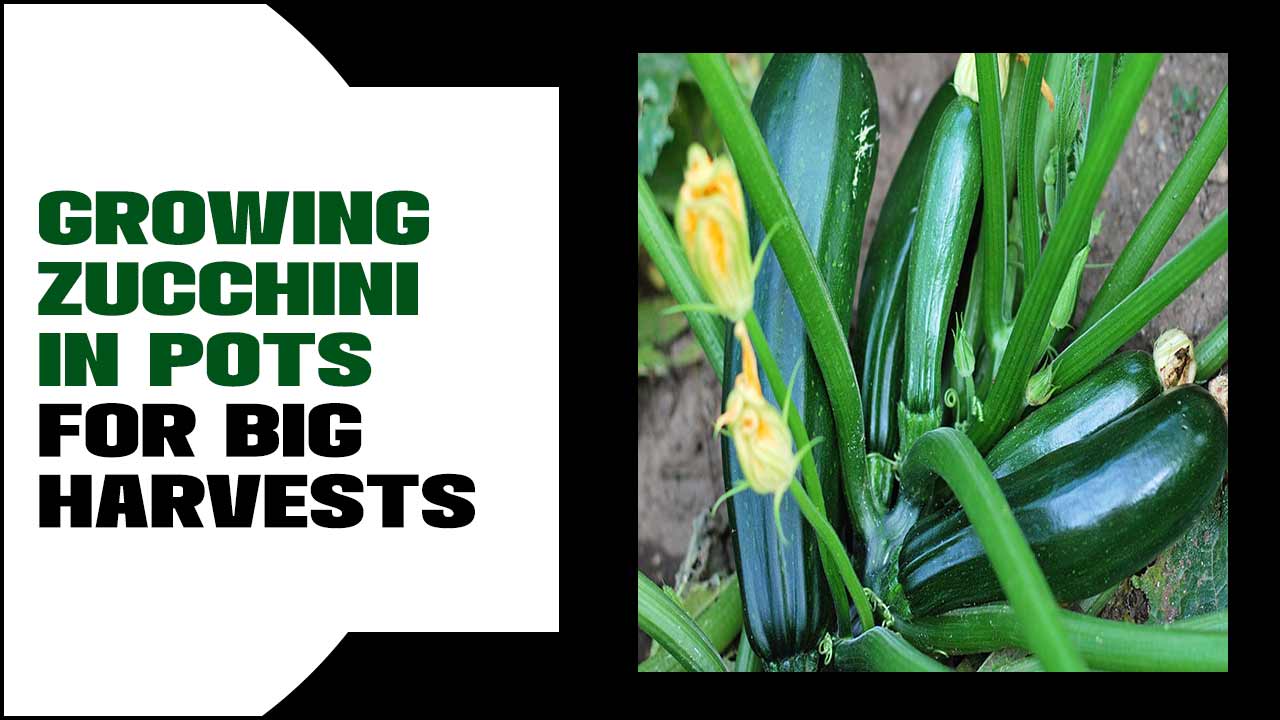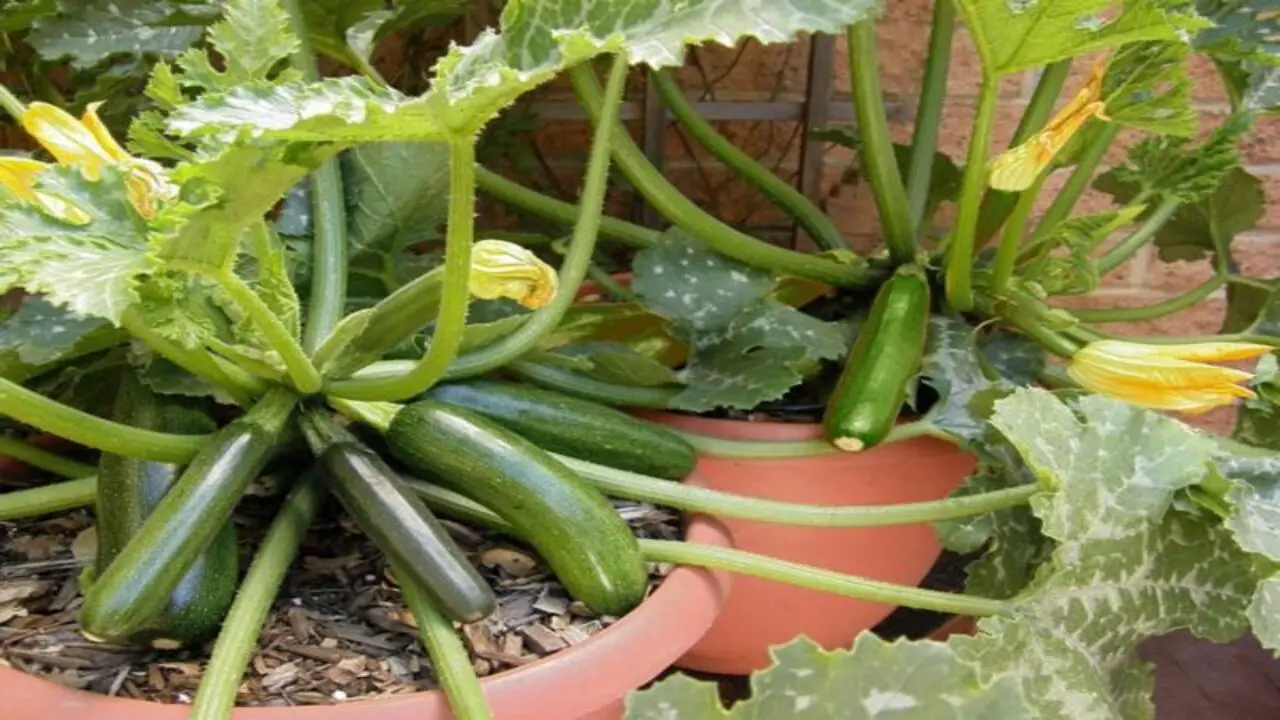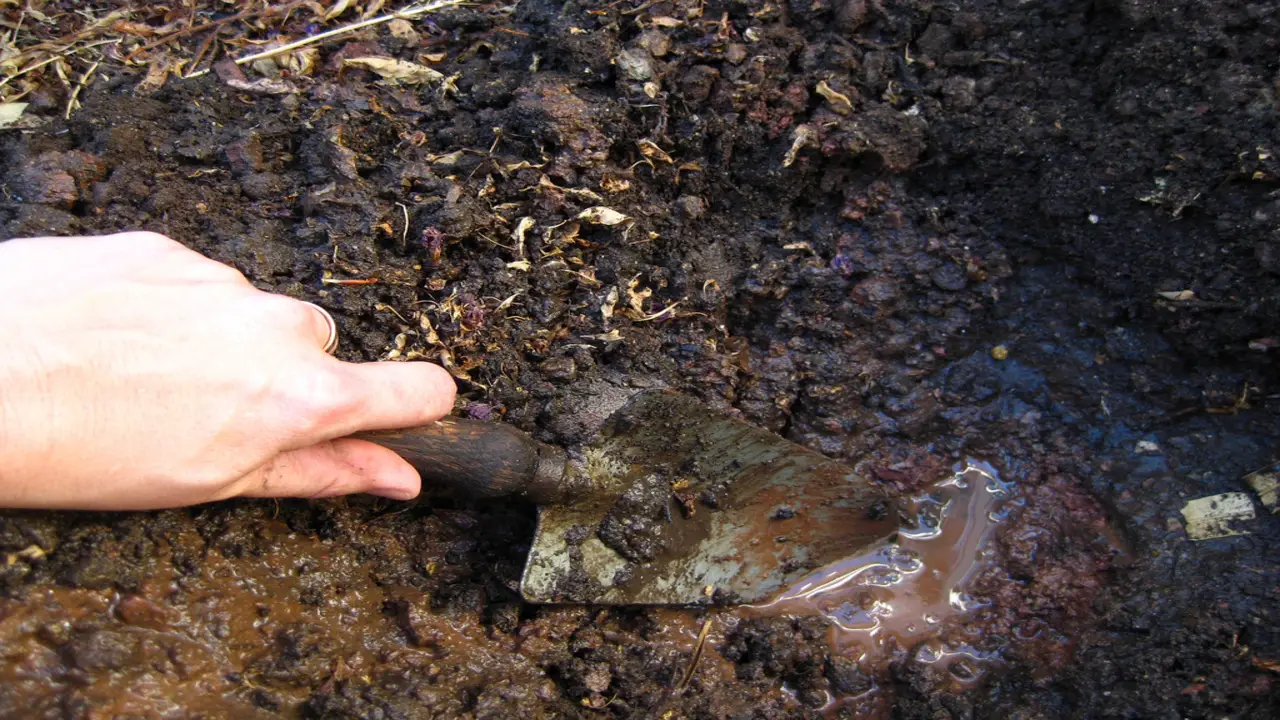Zucchini, also known as courgette, is a versatile and nutritious vegetable that is a staple in many kitchens. Its mild flavour and ability to thrive in various growing conditions make it a favourite among home gardeners.
However, for those with limited space, growing zucchini in traditional garden beds may not be an option. That’s where growing zucchini in pots comes in. With the right techniques and care, you can achieve bountiful harvests of this beloved vegetable right in your own backyard or even on a balcony.
Here we will cover everything from growing zucchini in pots for big harvests. We will also provide tips on supporting and monitoring your plants for pests and diseases. Additionally, we will discuss when to harvest your zucchinis and how to handle frost threats.

7 Tips For Growing Zucchini In Pots For Big Harvests

Growing zucchini in pots offers several advantages for both experienced gardeners and beginners. One of the key benefits is the ability to save garden space while enjoying a bountiful zucchini harvest. Growing zucchini in pots can be a great way to enjoy big harvests, even with limited space.
Following these tips, you can grow zucchini in pots and enjoy bountiful harvests of this delicious vegetable throughout the growing season. Here are 7 tips on growing zucchini in pots for big harvests:
Choose The Right Pot
When growing zucchini in pots, choosing the right container is crucial. Opt for a large pot with a minimum depth of 18 inches to accommodate the plant’s extensive root system. Ensure the pot has adequate drainage holes to prevent waterlogging and root rot.
Consider using terracotta or porous material pots as they provide better air circulation to the roots. Planting only one zucchini plant per pot is best to avoid overcrowding. Select a pot that matches the size of your zucchini plant and allows room for growth. Choosing the right pot will provide an ideal environment for your zucchini plants to thrive and yield abundant harvests.
Use Well-Draining Soil

When growing zucchini in pots for big harvests, it’s essential to use well-draining soil. Choose a high-quality potting mix that provides good drainage to ensure optimal growth and development of your zucchini plants. Enhance the soil structure and water retention by adding organic matter like compost or peat moss.
Avoid using garden soil in pots, as it can become compacted and restrict root growth. The potting mix should be loose and friable, allowing for proper root development. Regularly test the soil’s moisture level to hydrate your zucchini plants properly. Well-draining soil will create an ideal environment for healthy and productive zucchini plants in your container garden.
Provide Adequate Sunlight
Providing adequate sunlight is crucial to ensure the healthy growth of your zucchini plants in pots. Place the pots in a location that receives a minimum of 6-8 hours of direct sunlight daily. Make sure no obstructions, like nearby trees or buildings, shade the plants. Rotate the pots regularly to ensure all sides of the plant receive equal sunlight exposure.
If you notice any shaded areas, you can use reflective materials or mirrors to redirect sunlight to those areas. However, watch for signs of sunburn during extreme heat and provide temporary shade if necessary. Remember, ample sunlight is vital for a bountiful zucchini harvest.
Water Regularly
To ensure successful growth, water zucchini pots consistently, keeping the soil evenly moist without waterlogging. Check the soil’s moisture level by inserting your finger about an inch deep into it. Adjust watering frequency based on weather conditions and plant moisture needs.
Remember to water at the base of the plant to avoid wetting the foliage, which can lead to fungal diseases. Consider using a drip irrigation system or self-watering pots for efficient and consistent watering. With regular and proper watering, your zucchini plants will thrive and produce a bountiful harvest.
Fertilize Regularly

To ensure healthy growth and abundant harvests, it’s important to fertilize your zucchini plants regularly. A balanced liquid fertilizer should be applied every 2-3 weeks throughout the growing season, providing essential nutrients for optimal development. Following the manufacturer’s instructions regarding dosage and application methods is crucial.
Organic fertilizers like compost tea or fish emulsion can be used for a more natural approach. However, over-fertilizing should be avoided as it can lead to excessive vegetative growth at the expense of fruit production. Keep a close eye on your plants for any signs of nutrient deficiencies and adjust the fertilization accordingly. Regularly fertilising promotes healthy growth and ensures a bountiful zucchini harvest.
Support The Plants
To ensure the healthy growth of your zucchini plants, it is important to provide them with adequate support. A tomato cage or trellis can support the zucchini plant, preventing it from bending or breaking under the weight of the growing fruits. Another option is to place a stake next to the zucchini and tie the plant to it for added support.
Bamboo stakes or garden twine can also create a support structure. Regularly monitor the plant for any signs of drooping or wilting and provide additional support if needed. You can ensure a bountiful harvest of delicious zucchini by supporting your plants.
Monitor For Pests And Diseases
To ensure the health and productivity of your zucchini plants, it’s essential to monitor for pests and diseases. Watch for common pests like squash bugs and cucumber beetles that can wreak havoc on your plants. Inspect the leaves and stems for any signs of powdery mildew, a fungal disease that can inhibit growth.
Yellowing or browning leaves may indicate a nutrient deficiency or fungal infection, so be vigilant in spotting these symptoms. Be sure to check the leaves for holes or chew marks, as they indicate the presence of pests. Regularly monitoring the base of the plant is crucial for catching early signs of bacterial wilt or vine borers. By staying proactive and observant, you can address any issues promptly and protect your zucchini plants from potential damage.
Choosing The Best Zucchini Varieties For Pots

When growing zucchini in pots, choosing the right varieties can make a big difference in your harvest. By selecting the right zucchini varieties for your pots, you can maximize your harvest and enjoy fresh, homegrown zucchini throughout the season. Here are some tips for selecting the best zucchini varieties for pots:
- Look for compact or bushy varieties that don’t require a lot of space to grow.
- Consider the size of your pot and choose varieties suitable for container gardening.
- Check the maturity time of the variety to ensure that it will have enough time to grow and produce fruit before the end of the growing season.
- Pay attention to disease resistance. Some varieties, such as powdery mildew, are more resistant to common zucchini diseases.
When Is The Right Time To Harvest Your Zucchini?
Harvest your zucchini when they reach a length of 6 to 8 inches. Look for dark green, glossy skin. Avoid letting them grow too large, as they can become tough and seedy. Regular harvesting promotes continuous production. Use a sharp knife or pruning shears to cut them from the plant.
How To Handle Frost Threats To Your Zucchini Plants?
Knowing when to harvest your zucchini is crucial for achieving big, flavorful harvests. Once your zucchini plants start producing fruits, monitoring them closely is important. The ideal time to harvest zucchini is when they are around 6 to 8 inches long and have a glossy skin.
They may become tough and less flavorful if you allow them to grow too large. It’s also important to harvest regularly to encourage continuous production. Use a sharp knife or shears to cut the zucchini from the plant, not damaging the vines or other fruits. With proper timing and harvesting techniques, you’ll enjoy an abundance of delicious zucchini in no time.
Troubleshooting Common Issues With Container-Grown Zucchini

Growing zucchini in pots can be a rewarding experience, but it’s not without challenges. If you’re experiencing issues with your container-grown zucchini. You can maximise your harvest by addressing these common issues with container-grown zucchini. Here are some troubleshooting tips to help you out:
- Lack Of Fruit Production: If your zucchini plant is not producing fruit, it may be due to a lack of pollination. Zucchini plants use bees and other insects to transfer pollen between male and female flowers. To encourage pollination, you can hand-pollinate the flowers by gently transferring the pollen from the male flowers to the female ones using a small brush or cotton swab.
- Yellowing Leaves: Yellowing leaves can indicate several issues, including nutrient deficiencies, overwatering, or pests. Check the soil moisture levels and adjust your watering accordingly. Also, make sure that your plant is receiving adequate sunlight and nutrients. Consider using a balanced fertilizer specifically formulated for vegetables to provide essential nutrients.
- Powdery Mildew: Powdery mildew is a common fungal disease that affects zucchini plants. It appears as a white powdery coating on the leaves and stems. To prevent powdery mildew, ensure good air circulation around your plants and avoid overhead watering. If you notice signs of powdery mildew, treat it with an organic fungicide or a homemade solution of milk and water.
- Pests: Zucchini plants can attract pests such as aphids, squash bugs, and cucumber beetles. Monitor your plants regularly for signs of pests and take appropriate measures to control them. This may include handpicking them off the plants or using organic insecticides.
Preventing Common Pests And Diseases In Potted Zucchini Plants

Preventing common pests and diseases is crucial when growing zucchini in pots. Potted plants are more susceptible to infestations and infections, so taking proactive measures is key. By following these tips, you can minimize the risk of pests and diseases affecting your potted zucchini plants and maximize your chances of a bountiful harvest. Here are some tips to help protect your zucchini plants:
- Regularly inspect your plants for signs of pests such as aphids, squash bugs, or cucumber beetles. If you notice any, remove them by hand or use organic pest control methods.
- Provide proper drainage for your pots to prevent waterlogged soil, which can lead to root rot and other diseases. Ensure that excess water can drain out freely.
- Use a well-draining potting mix rich in organic matter to give your plants the right balance of nutrients.
- Promote air circulation around your potted zucchini plants by spacing them adequately and avoiding overcrowding.
- Mulch the soil’s surface with straw or wood chips to suppress weed growth and reduce moisture evaporation.
Tips For Maximizing Your Zucchini Harvest In Pots

If you want to maximize your zucchini harvest in pots, you can follow a few tips. First, choose a large enough pot that allows for ample root growth. A pot with a diameter of at least 18 inches is recommended. Next, ensure that the pot has proper drainage to prevent waterlogged soil. Use high-quality potting soil rich in organic matter and provides good nutrition for your zucchini plants.
Regularly fertilize your plants with a balanced fertilizer to promote healthy growth and abundant fruit production. Additionally, zucchini plants require plenty of sunlight, so place your pots in a sunny location or use grow lights if necessary. Finally, regularly water your plants, as zucchinis have high water needs. Following these tips, you can enjoy big harvests of fresh and delicious zucchinis from your pots.
Conclusion
Growing zucchini in pots can be a rewarding experience, offering convenience and flexibility for gardeners with limited space. By following the tips on growing zucchini in pots for big harvests, you can enjoy big harvests of delicious zucchini right from your own patio or balcony.
From choosing the right pot and soil to providing adequate sunlight and regular watering, each step plays a crucial role in the success of your zucchini plants. Additionally, supporting the plants, monitoring for pests and diseases, and knowing when to harvest are all essential factors.
By growing zucchini in pots, you can enjoy numerous benefits, such as easy maintenance, better soil quality control, and extending the growing season. So, whether you’re a seasoned gardener or just starting out, try container gardening and enjoy the bountiful harvests of fresh zucchini.
Frequently Asked Questions
1.Does Zucchini Do Well In Pots?
Ans: Zucchini can thrive in pots if you choose a large enough container. A minimum size of 5 gallons is recommended. Use high-quality soil with good drainage, and make sure to water and fertilize regularly for healthy zucchini plants in pots.
2.Which Zucchini Varieties Grow Best In Containers?
Ans: Zucchini varieties that excel in containers include Bush Baby, Astia, and Raven. Look for compact varieties with shorter growth cycles. Choose a pot at least 12 inches deep and wide enough for growth. Consistent fertilization and watering will promote healthy growth and abundant harvests.
3.Why Grow Zucchini In A Container?
Ans: Growing zucchini in containers offers space-saving benefits for those with limited garden space. It allows better control of soil quality and moisture levels, making protecting plants from pests and diseases easier. Containers can also be moved to optimize sunlight exposure, resulting in healthier plants and bigger harvests.
4.Is It Possible To Grow Zucchini In Pots?
Ans: Yes, zucchini can be successfully grown in pots. Choose a pot with a minimum diameter of 24 inches and a depth of 12 inches. Use high-quality potting soil and fertilize regularly. Water deeply but avoid over-watering to prevent root rot.
5.Can I Grow Zucchini In A Small Space And Still Get A Big Harvest?
Ans: Absolutely! Growing zucchini in pots is a great option for small spaces. Choose a deep and wide pot, fertilize and water regularly, and consider using trellises or vertical supports. You can still enjoy a big harvest of delicious zucchini with the right care.
